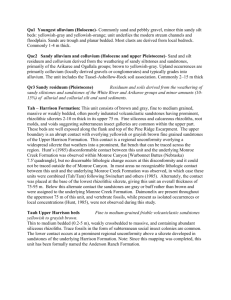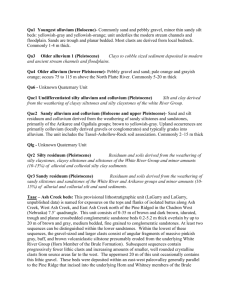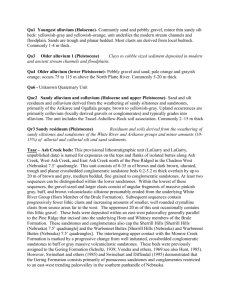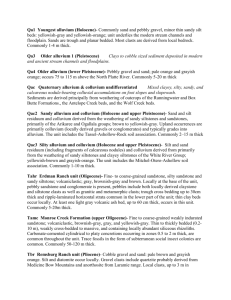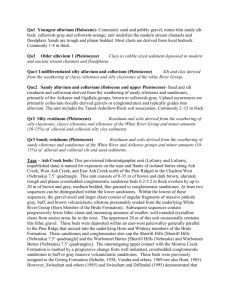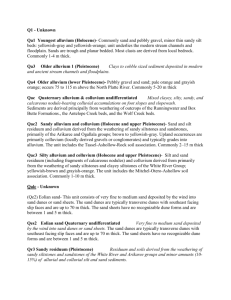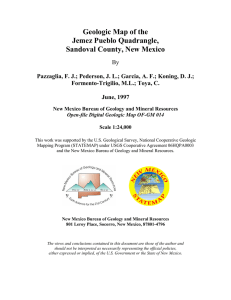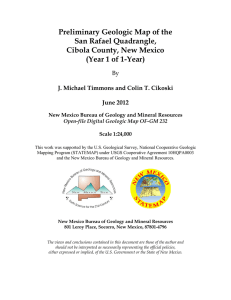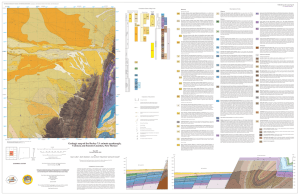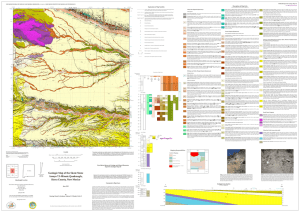Qa1 Youngest alluvium (Holocene)
advertisement
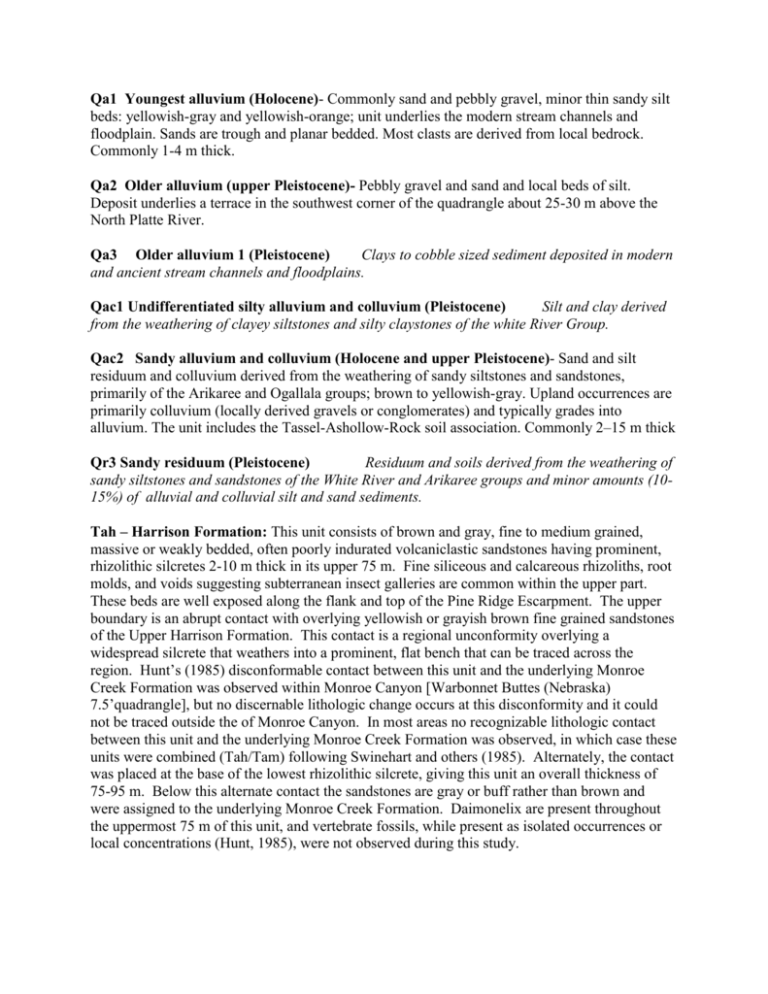
Qa1 Youngest alluvium (Holocene)- Commonly sand and pebbly gravel, minor thin sandy silt beds: yellowish-gray and yellowish-orange; unit underlies the modern stream channels and floodplain. Sands are trough and planar bedded. Most clasts are derived from local bedrock. Commonly 1-4 m thick. Qa2 Older alluvium (upper Pleistocene)- Pebbly gravel and sand and local beds of silt. Deposit underlies a terrace in the southwest corner of the quadrangle about 25-30 m above the North Platte River. Qa3 Older alluvium 1 (Pleistocene) Clays to cobble sized sediment deposited in modern and ancient stream channels and floodplains. Qac1 Undifferentiated silty alluvium and colluvium (Pleistocene) Silt and clay derived from the weathering of clayey siltstones and silty claystones of the white River Group. Qac2 Sandy alluvium and colluvium (Holocene and upper Pleistocene)- Sand and silt residuum and colluvium derived from the weathering of sandy siltstones and sandstones, primarily of the Arikaree and Ogallala groups; brown to yellowish-gray. Upland occurrences are primarily colluvium (locally derived gravels or conglomerates) and typically grades into alluvium. The unit includes the Tassel-Ashollow-Rock soil association. Commonly 2–15 m thick Qr3 Sandy residuum (Pleistocene) Residuum and soils derived from the weathering of sandy siltstones and sandstones of the White River and Arikaree groups and minor amounts (1015%) of alluvial and colluvial silt and sand sediments. Tah – Harrison Formation: This unit consists of brown and gray, fine to medium grained, massive or weakly bedded, often poorly indurated volcaniclastic sandstones having prominent, rhizolithic silcretes 2-10 m thick in its upper 75 m. Fine siliceous and calcareous rhizoliths, root molds, and voids suggesting subterranean insect galleries are common within the upper part. These beds are well exposed along the flank and top of the Pine Ridge Escarpment. The upper boundary is an abrupt contact with overlying yellowish or grayish brown fine grained sandstones of the Upper Harrison Formation. This contact is a regional unconformity overlying a widespread silcrete that weathers into a prominent, flat bench that can be traced across the region. Hunt’s (1985) disconformable contact between this unit and the underlying Monroe Creek Formation was observed within Monroe Canyon [Warbonnet Buttes (Nebraska) 7.5’quadrangle], but no discernable lithologic change occurs at this disconformity and it could not be traced outside the of Monroe Canyon. In most areas no recognizable lithologic contact between this unit and the underlying Monroe Creek Formation was observed, in which case these units were combined (Tah/Tam) following Swinehart and others (1985). Alternately, the contact was placed at the base of the lowest rhizolithic silcrete, giving this unit an overall thickness of 75-95 m. Below this alternate contact the sandstones are gray or buff rather than brown and were assigned to the underlying Monroe Creek Formation. Daimonelix are present throughout the uppermost 75 m of this unit, and vertebrate fossils, while present as isolated occurrences or local concentrations (Hunt, 1985), were not observed during this study. Tam Monroe Creek Formation (Oligocene) Fine to coarse-grained weakly indurated, sandstone, volcaniclastic, brown, buff, and gray. Thin to thickly bedded (0.2-10 m), weakly cross-bedded to massive, and containing locally abundant siliceous rhizoliths. Carbonate-cemented cylindrical to platy concretions occurring in zones 0.5 to 2 m thick, are common throughout the unit. Trace fossils in the form of subterranean social insect colonies are common. Vertebrate fossils are rare, and only fragments of tortoise carapace were recovered during the mapping. The lower contact where visible, is a sharp erosional contact with the Sharps Member of the Brule Formation. This unit is between 150-190 m thick depending how the upper contact was established (see above). Tmr Runningwater Formation (Miocene) Medium-to fine-grained sandstones, coarse sands, sandy siltstones, and gravels, and locally occurring clayey silts and volcanic ash beds; gray, greenish-gray, and brown. The gravels contain abundant Rocky Mountain-source clasts. Calcareous-cemented zones from 0.2 to 1.5 m thick are locally common. The unit occurs in a generally eastward trending paleovalley and is up to 100 m thick. Ukn – Unknown mapping unit. These areas were either not labeled or were not legible on the original maps.
